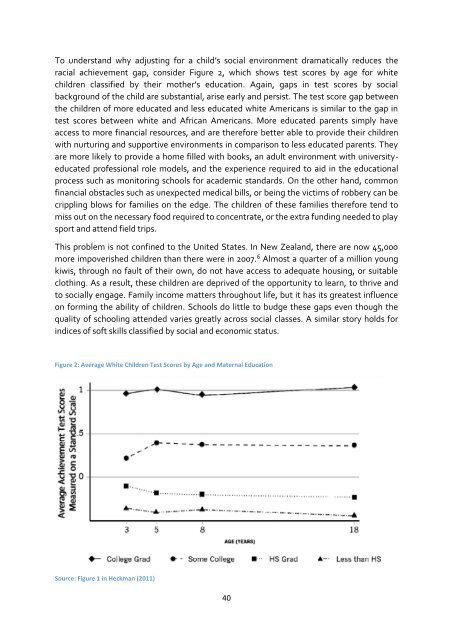UNCONSCIOUS BIAS AND EDUCATION
unconsious-bias-and-education
unconsious-bias-and-education
Create successful ePaper yourself
Turn your PDF publications into a flip-book with our unique Google optimized e-Paper software.
To understand why adjusting for a child’s social environment dramatically reduces the<br />
racial achievement gap, consider Figure 2, which shows test scores by age for white<br />
children classified by their mother’s education. Again, gaps in test scores by social<br />
background of the child are substantial, arise early and persist. The test score gap between<br />
the children of more educated and less educated white Americans is similar to the gap in<br />
test scores between white and African Americans. More educated parents simply have<br />
access to more financial resources, and are therefore better able to provide their children<br />
with nurturing and supportive environments in comparison to less educated parents. They<br />
are more likely to provide a home filled with books, an adult environment with universityeducated<br />
professional role models, and the experience required to aid in the educational<br />
process such as monitoring schools for academic standards. On the other hand, common<br />
financial obstacles such as unexpected medical bills, or being the victims of robbery can be<br />
crippling blows for families on the edge. The children of these families therefore tend to<br />
miss out on the necessary food required to concentrate, or the extra funding needed to play<br />
sport and attend field trips.<br />
This problem is not confined to the United States. In New Zealand, there are now 45,000<br />
more impoverished children than there were in 2007. 6 Almost a quarter of a million young<br />
kiwis, through no fault of their own, do not have access to adequate housing, or suitable<br />
clothing. As a result, these children are deprived of the opportunity to learn, to thrive and<br />
to socially engage. Family income matters throughout life, but it has its greatest influence<br />
on forming the ability of children. Schools do little to budge these gaps even though the<br />
quality of schooling attended varies greatly across social classes. A similar story holds for<br />
indices of soft skills classified by social and economic status.<br />
Figure 2: Average White Children Test Scores by Age and Maternal Education<br />
Source: Figure 1 in Heckman (2011)<br />
40


